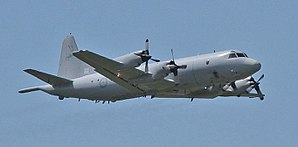AP-3C Orion
| AP-3C Orion | |
|---|---|
 |
|
| AP-3C Orion | |
| Role | Maritime patrol aircraft |
| National origin | United States / Australia |
| Manufacturer |
Lockheed Corporation Sensor systems by L3 Communications / Tenix Defence |
| First flight | 19 May 1999 |
| Introduction | 2002 |
| Status | Active |
| Primary user | Royal Australian Air Force |
| Number built | 18 |
| Developed from | Lockheed P-3 Orion |
The Lockheed AP-3C Orion is a variant of the P-3 Orion used by the Royal Australian Air Force (RAAF) for tasks such as naval fleet support, maritime surveillance, search and survivor supply and anti-surface and anti-submarine warfare. The 18 AP-3C Orions were upgraded from P-3Cs between 1997 and 2005, with the program taking three years longer than expected due to systems integration problems. All 18 AP-3C Orions are operated by No. 92 Wing which is based at RAAF Base Edinburgh in South Australia. Aircraft from the wing have seen service as part of Australian Defence Force operations in Australia, South East Asia and the Middle East.
The AP-3C Orion project began in the early 1990s to upgrade the radar and mission systems on 18 of Australia's 19 P-3C-II Orions. L3 Communications completed the prototype AP-3C at its facility at Greenville, Texas. The other 17 aircraft were upgraded at Avalon Airport in Australia under a sub-contract to Australian companies. Tenix Defence took over the project in mid-2003 and BAE Systems was involved with many of the aircraft's sub-systems and developing a simulation facility. Work began on the first AP-3C in January 1997 and the original project schedule called for this aircraft to be provided to the RAAF for operational acceptance trials in March 1998 and all upgrades to be completed by the end of 2001. The remaining 19th Orion was not included in the upgrade program, and the Australian military stated in 2005 that it is "used for development purposes".
When the Australian Orion upgrade project was being developed in 1996 there was not an 'off the shelf' package of upgrades that met the requirements specified by the RAAF. As a result, it was decided to tailor the upgrade to Australian specifications, which included integrating different systems. The systems integration task proved to be much more difficult than was expected, and L3 Communications and its suppliers were required to write over two million lines of software code.
As a result of the systems integration problems delivery of upgraded Orions was delayed by three years. The first two aircraft were handed over to the RAAF in December 2001 and the final AP-3C was delivered in early 2005. This delay caused a major reduction in the RAAF's maritime surveillance capability, and in February 2001 only nine of the RAAF's 17 Orions were operational.
...
Wikipedia
